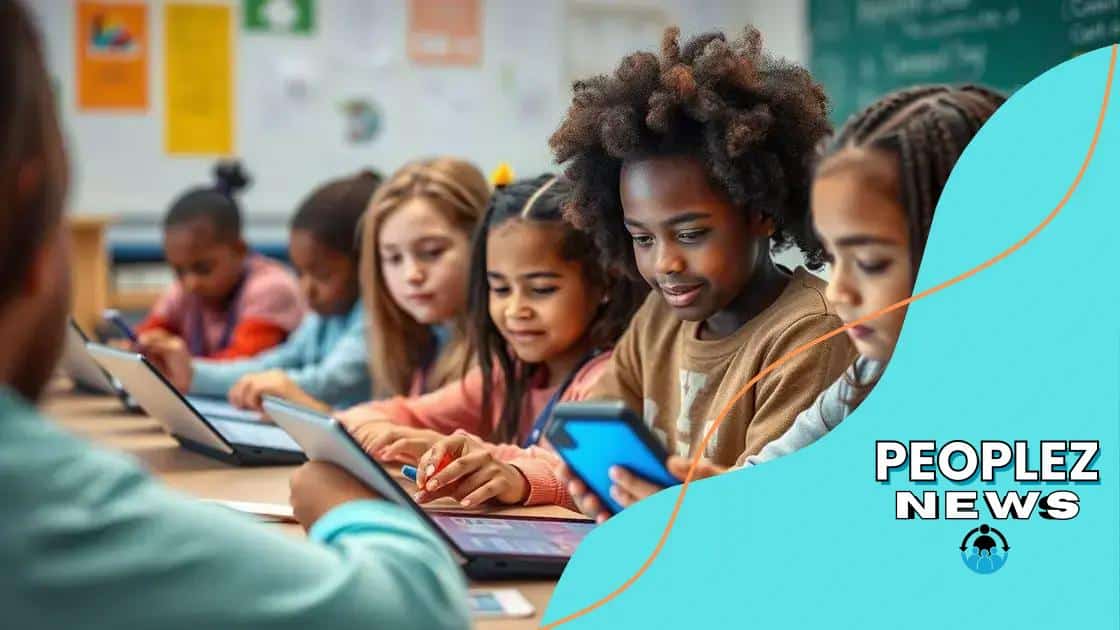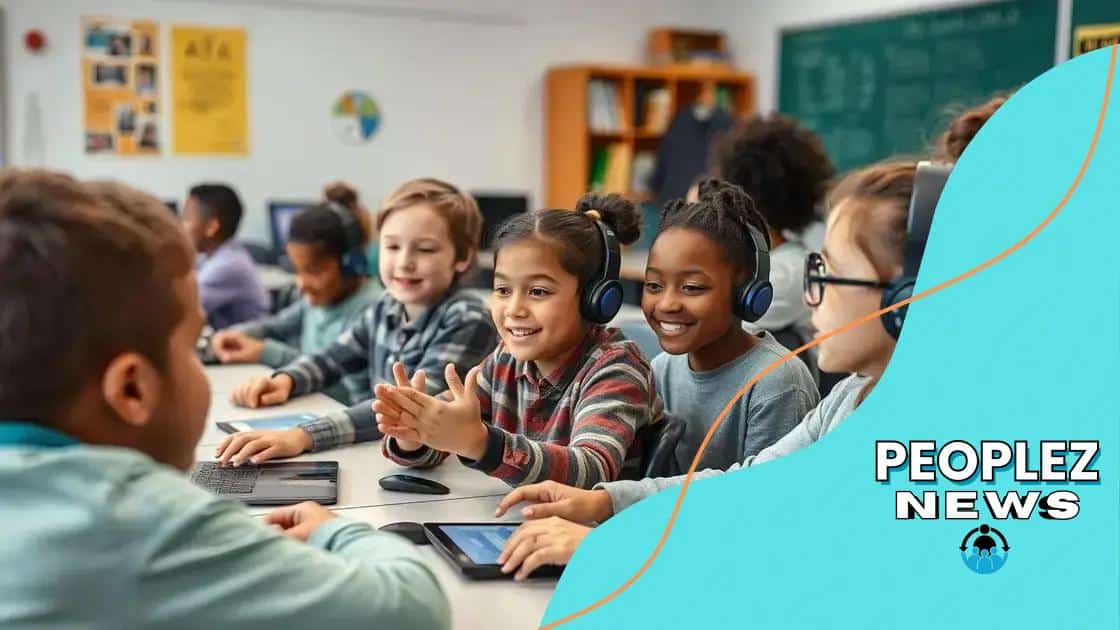AI tools in special education for personalized learning

AI tools in special education enhance personalized learning by providing tailored support, improving accessibility, and fostering engagement for students with diverse needs.
AI tools in special education are transforming how educators approach personalized learning. Have you ever wondered how these technologies tailor experiences to meet individual needs? Let’s dive into this exciting topic.
Understanding the role of AI in special education
Artificial Intelligence (AI) is becoming crucial in special education. As schools aim to provide tailored learning experiences, AI tools help cater to each student’s unique needs. With early intervention and personalized strategies, AI offers exciting possibilities.
How AI Enhances Learning
AI enhances learning through adaptive technologies. These smart tools analyze data and adjust teaching methods accordingly. Some benefits include:
- Individualized learning plans
- Real-time feedback for students
- Supporting educators with tailored resources
Students who need extra help can find personalized support easily with AI. For example, an AI program can detect when a student struggles with a specific concept and suggest additional activities tailored to their needs.
Furthermore, AI can aid in simplifying complex tasks. For children with disabilities, simple technologies can make learning more accessible. Voice recognition, for instance, allows students with writing difficulties to complete assignments easily.
Benefits for Educators
Educators also benefit from AI tools. By analyzing student performance data, teachers can identify where each child excels or struggles. This information enables teachers to implement targeted interventions. Some key advantages include:
- Saving time on administrative tasks
- Accessing insights on student progress
- Creating efficient lesson plans
As teachers harness these insights, they can ensure their teaching methods resonate with every student. AI tools also offer educators valuable resources, allowing them to focus on teaching rather than paperwork.
Ultimately, understanding the role of AI in special education opens doors to innovative possibilities. The merging of technology and education creates an enriching environment for everyone involved.
Personalized learning strategies using AI tools
Personalized learning strategies using AI tools are changing how students engage with their studies. AI adapts to each learner’s needs, allowing for a customized educational experience. This tailored approach not only boosts academic performance but also encourages students to take an active role in their learning journey.
Types of AI Tools for Learning
There are many types of AI tools designed to enhance personalized learning. These include:
- Intelligent tutoring systems that offer one-on-one support
- Learning management systems that customize course material
- Data analytics tools that track student progress in real-time
These technologies display flexibility, enabling adjustments based on student performance. For example, intelligent tutoring systems can provide extra practice for a student struggling with math while moving ahead for others who grasp concepts quicker.
Given the wide variety of tools, choosing the right ones can seem overwhelming. However, focusing on tools that align with student needs is essential. AI tools not only facilitate personalized instruction but also empower educators to make informed decisions about their teaching strategies.
Implementing AI in the Classroom
Implementing AI tools in the classroom should be done thoughtfully. Here are some strategies to ensure success:
- Train educators on how to use AI effectively
- Evaluate tools based on student outcomes
- Involve students in the decision-making process
By carefully incorporating AI, schools can transform their teaching methods. Teachers gain insights into their students’ learning styles and challenges, which enhances classroom dynamics. This knowledge helps create a supportive and productive learning environment.
When students engage with these personalized learning strategies, they become more invested in their education. By using AI, teachers can connect better with each student, ensuring no one falls behind.
Benefits of AI for students with disabilities
 The benefits of AI for students with disabilities are profound and transformative. AI technologies provide tailored support, making learning more accessible and engaging. By addressing unique challenges, these tools empower students to achieve their full potential in educational settings.
The benefits of AI for students with disabilities are profound and transformative. AI technologies provide tailored support, making learning more accessible and engaging. By addressing unique challenges, these tools empower students to achieve their full potential in educational settings.
Enhanced Accessibility
AI can significantly enhance accessibility in learning environments. Many tools are designed to help students overcome barriers. Key advantages include:
- Speech recognition tools that assist students in expressing their thoughts
- Text-to-speech features that read content aloud for better comprehension
- Adaptive learning programs that adjust content based on student needs
These features allow students to interact with materials that suit their learning styles, making education a more inclusive experience. For instance, a student with dyslexia may benefit from text-to-speech technology, facilitating their understanding of reading assignments.
In addition to accessibility tools, AI offers strategies that promote independence. By providing custom learning paths, students can navigate their studies at their own pace without feeling overwhelmed. This individualized approach often leads to greater confidence and improved outcomes.
Improved Engagement and Motivation
Another significant benefit of AI is the increase in student engagement and motivation. Interactive AI-driven applications capture students’ interest and make learning fun. Some effective strategies include:
- Gamified learning experiences that reward progress and achievements
- Personalized feedback that encourages students to improve
- Real-time tracking of learning milestones to highlight growth
As students see their progress, they become more motivated to participate actively in their education. More importantly, this engagement helps address feelings of frustration some students may experience. When students can learn in enjoyable ways suited for them, their enthusiasm for school can dramatically increase.
Overall, these benefits demonstrate how AI is reshaping education for students with disabilities. When utilized effectively, AI tools can make learning environments more equitable and empowering for every student.
Real-world examples of AI applications in education
Real-world examples of AI applications in education are transforming how students learn and teachers instruct. Schools are beginning to leverage AI technologies to create more dynamic and effective learning environments. These advancements provide practical solutions to common educational challenges.
Adaptive Learning Platforms
One notable application of AI is the use of adaptive learning platforms. These tools adjust the learning experience based on individual student data. Some key features of these platforms include:
- Customized learning paths that cater to each student’s strengths and weaknesses
- Instant feedback that keeps students engaged and informed
- Data analytics that offer insights for educators to tailor their instruction
For example, platforms like DreamBox and IXL use data to adapt math lessons in real time, providing personalized support that matches students’ needs. This ensures that no student is left behind in their learning journey.
Another innovative use of AI can be seen in intelligent tutoring systems. These systems simulate one-on-one tutoring experiences, making learning more accessible. Students can ask questions and receive instant responses, aiding their understanding of complex topics. When students struggle, the system can offer additional resources or change the teaching approach to help clarify concepts.
AI in Special Education
AI applications are particularly impactful in special education. Tools like speech recognition software assist students with communication challenges. These programs read texts aloud or transcribe spoken words into written form. They are designed to empower students with disabilities, helping to bridge gaps in learning. Some widely used tools include:
- Text-to-speech applications that enhance reading comprehension
- Augmentative and alternative communication (AAC) devices for those who cannot speak
- Visual AI aids that help in understanding patterns and concepts
By adopting these AI tools, teachers can create inclusive classrooms that cater to diverse learning needs. For instance, a student with autism spectrum disorder may benefit from visual learning aids that present information in a clear, structured manner.
With these real-world examples, it’s evident that AI applications in education are reshaping how content is delivered and understood. Schools that embrace these technologies can create more engaging, personalized, and effective learning experiences for all students.
Challenges and considerations in implementing AI tools
Implementing AI tools in education brings a variety of challenges and considerations that educators must address. While these tools offer significant advantages, understanding potential barriers is essential for successful integration. AI technologies can enhance learning, but they also require careful planning and execution.
Technical Barriers
One key challenge in implementing AI is the technological infrastructure required. Many schools may lack the necessary hardware and software to support advanced AI applications. Important factors include:
- High-speed internet access and reliable connectivity
- Up-to-date devices like computers or tablets for students
- Support for software updates and maintenance
Without robust technology systems in place, educators can struggle to use AI tools effectively. For instance, if students cannot access the required devices or internet connection, the intended benefits of personalized learning may not be realized.
Training and Professional Development
Another significant consideration is the need for training and professional development. Teachers must feel confident and knowledgeable when using AI tools in their classrooms. Some key elements include:
- Hands-on training sessions focusing on specific AI applications
- Ongoing support and resources for teachers as they adapt to new technologies
- Collaboration with peers to share best practices and experiences
If educators do not receive adequate training, they may not utilize these tools to their fullest potential. Teachers should be empowered to explore the features of AI technologies comfortably and effectively.
Beyond technical and training barriers, ethical implications also arise when using AI in education. Issues such as data privacy and student consent must be addressed. Educators need to understand how student data is collected and used by AI tools. Transparent communication regarding data policies is essential to build trust between schools, students, and parents.
Furthermore, considering the diverse needs of all students is crucial. While AI tools can offer personalized learning experiences, they must be designed to cater to a variety of learning styles and abilities. Developers should work closely with educators to ensure that these tools remain inclusive and effective for every learner.
FAQ – Frequently Asked Questions about AI Tools in Education
What are the main benefits of using AI tools in education?
AI tools provide personalized learning experiences, enable real-time feedback, and enhance accessibility for students with diverse needs.
What challenges do schools face when implementing AI tools?
Schools often face challenges such as the need for proper technology infrastructure, teacher training, and addressing ethical considerations regarding data privacy.
How can AI tools assist students with disabilities?
AI tools can offer tailored support such as speech recognition, text-to-speech applications, and other assistive technologies to help students overcome learning barriers.
Why is teacher training important for AI implementation?
Teacher training is crucial because educators need to understand how to effectively utilize AI tools to enhance their teaching and support student learning.





